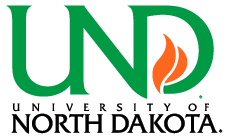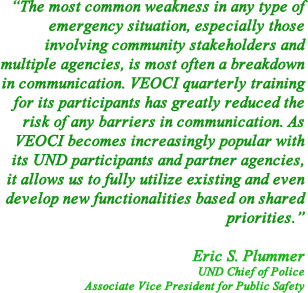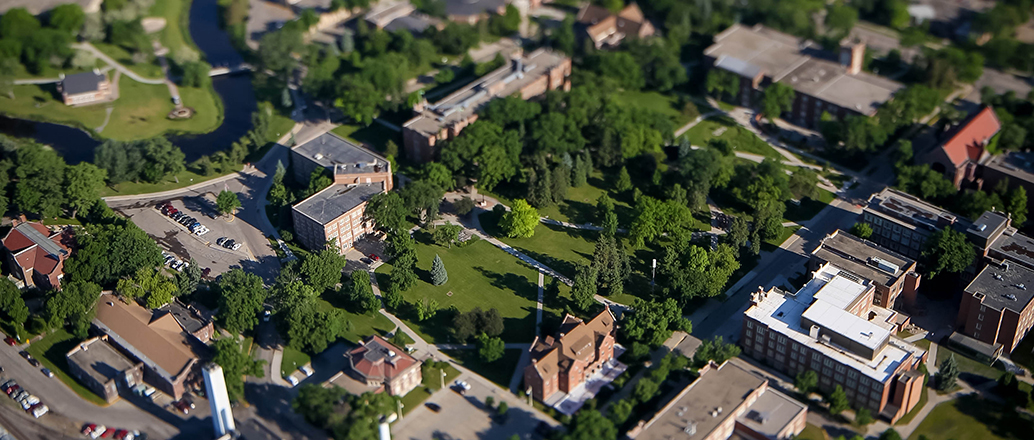University of North Dakota
Department of Public Safety & Office of Emergency Management
Background
The University of North Dakota (UND), in Grand Forks, ND, and founded in 1883, is the state’s oldest and largest university, with more than 15,000 students. It is also one of the top 100 doctoral research universities in the United States, attracting scholars and scientists from around the world. Phil Jackson, widely considered one of the greatest coaches in the history of Basketball, is a UND alumnus. As a major University, in its daily operations, UND’s Department of Public Safety and Office of Emergency Management need to exchange information among several teams and departments – Facilities Management, Operations Center, Public Safety, Campus Police – as well as with city, county, and officials from Grand Forks and the state capital in Bismarck. Daily briefings are held, and cover a broad range of topics such as current incidents and responses, upcoming events, severe weather predictions, existing issues, and any other events which may require/have required a response.

Problems/Challenges
One of the main gaps identified in UND’s daily briefing process was the lack of a centralized system to keep track of all the information that had to be updated and shared and also receive feedback and updates. Email had been the tool used to disseminate and receive information, and was proving inadequate and unreliable. Mass Notification systems are not suitable for the extensive interchange that is required for coordination.
Engaging all stakeholders and team members ensuring that they are notified and kept up-to-date on the latest briefings is the top priority for the Department of Public Safety and Office of Emergency Management. As process
enablers, emails have serious deficiencies: there is no guarantee that the mail will be read until the user logs on and checks their email; they are easy to lose among the volume of emails most people receive; they can branch off into multiple tangents where superfluous information is introduced and vital information is deleted; they are scattered and hard to track, with little in the way of an audit trail; and they do not lend themselves to analysis for mitigation, remediation or response plan improvement.
In short, as the Department of Public Safety and Office of Emergency Management saw it, the daily briefing communication process was unsatisfactory and had become increasingly inefficient, unreliable, and time-consuming.
Solution
The University of North Dakota’s Department of Public Safety and Office of Emergency Management began using VEOCI in June 2013. They established virtual rooms for Daily Briefings, Special Events, Training, and also developed a Campus Resources Map. The latter identifies the location of campus buildings; location of hazardous materials; building safety and security representatives list; building emergency action plans; and continuity of operations plans.

New Daily Briefing Rooms are created each month and contain daily posts, including operations center logs, University Police logs, news, weather, UND events, and health alerts. Attendees are able to participate from wherever they are, with all information they need just a click away. They can also provide comments and updates from their platform of choice. Prior to implementing VEOCI, UND’s Operations Center and University Police logs were not shared with other UND departments, executive administrators, or other agencies with any regularity or consistency. Another advantage: all logs are automatically indexed for search.
The University also uses VEOCI’s notification capabilities to alert executive administrators, Operations Center personnel, police force, emergency management staff, and city and county officials, and request them to check in to the specified rooms using their mobile devices.
As a quick and easy way to get incident commanders, safety managers, responders, and stakeholders communicating with each other and aware of their assignments, VEOCI is UND’s instant and virtual incident command system during emergencies. Everyone can participate from wherever they are.
Besides significantly enhancing information sharing and collaboration in real-time, the benefits that VEOCI provides to UND include:
- User-friendly platform that encourages participants to access it frequently
- Daily usage develops familiarity for confident usage when an emergency does occurs.
- True scalability, allowing for quick addition of more participants, rooms, and task assignments as incidents unfold and expand
- Central conduit for multiple agencies to interact not just for emergency responses, but also for mitigation, planning, resource management, and recovery
- Higher participation in drills because everyone does not have to re-locate to the EOC to participate.








